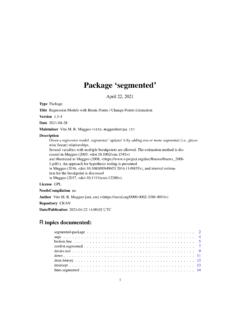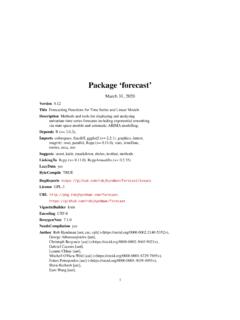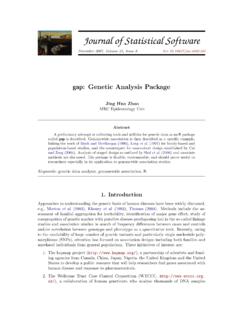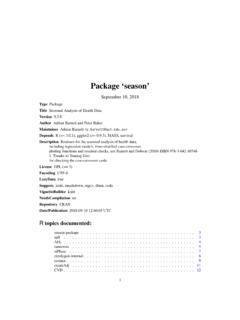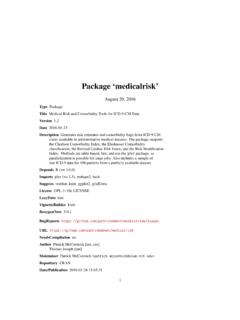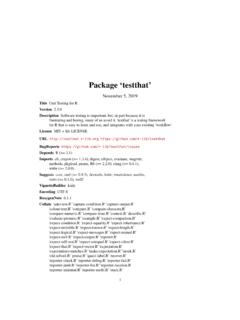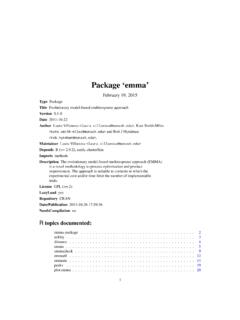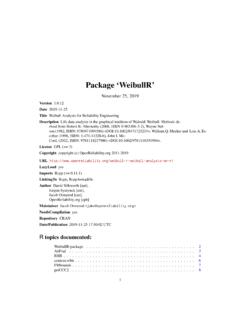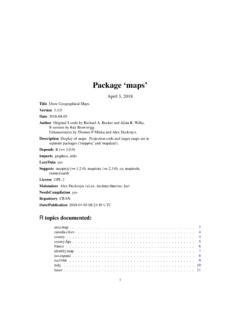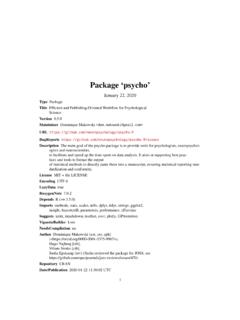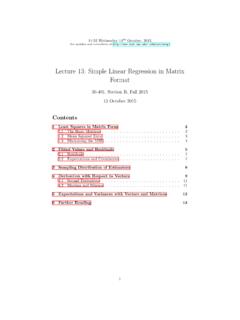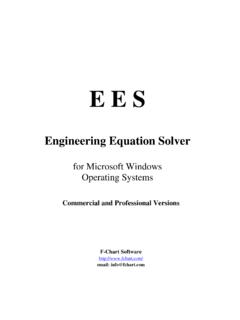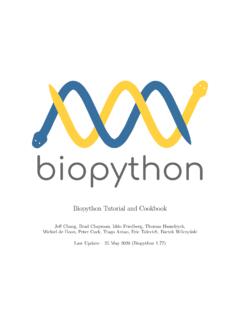Transcription of The Comprehensive R Archive Network
1 Package caret'. April 19, 2022. Title Classification and Regression Training Version Description Misc functions for training and plotting classification and regression models. License GPL (>= 2). URL BugReports Depends ggplot2, lattice (>= ), R (>= ). Imports e1071, foreach, grDevices, methods, ModelMetrics (>= ), nlme, plyr, pROC, recipes (>= ), reshape2, stats, stats4, utils, withr (>= ). Suggests BradleyTerry2, covr, Cubist, dplyr, earth (>= ), ellipse, fastICA, gam (>= ), ipred, kernlab, klaR, knitr, MASS, Matrix, mda, mgcv, mlbench, MLmetrics, nnet, pamr, party (>= ), pls, proxy, randomForest, RANN, rmarkdown, rpart, spls, subselect, superpc, testthat (>= ), themis (>= ). VignetteBuilder knitr Encoding UTF-8. RoxygenNote NeedsCompilation yes Author Max Kuhn [aut, cre] (< >), Jed Wing [ctb], Steve Weston [ctb], Andre Williams [ctb], Chris Keefer [ctb], Allan Engelhardt [ctb], Tony Cooper [ctb], Zachary Mayer [ctb], Brenton Kenkel [ctb], R Core Team [ctb], 1.
2 2 R topics documented: Michael Benesty [ctb], Reynald Lescarbeau [ctb], Andrew Ziem [ctb], Luca Scrucca [ctb], Yuan Tang [ctb], Can Candan [ctb], Tyler Hunt [ctb]. Maintainer Max Kuhn Repository CRAN. Date/Publication 2022-04-19 06:52:35 UTC. R topics documented: .. 4. avNNet .. 5. bag .. 8. bagEarth .. 11. bagFDA .. 13. BloodBrain .. 15. BoxCoxTrans .. 15. calibration .. 17. caretSBF .. 20. cars .. 21. classDist .. 22. confusionMatrix .. 24.. 27. cox2 .. 29. createDataPartition .. 30. defaultSummary .. 32.. 35. dhfr .. 36.. 37. dotPlot .. 39.. 40. downSample .. 41. dummyVars .. 42. extractPrediction .. 46. featurePlot .. 48. filterVarImp .. 49. findCorrelation .. 51. findLinearCombos .. 52.. 54.. 55. gafsControl .. 58. gafs_initial .. 61. GermanCredit .. 63. getSamplingInfo .. 64. R topics documented: 3.. 65.. 66.. 69.. 70. index2vec.
3 72. knn3 .. 73. knnreg .. 74. learning_curve_dat .. 76. lift .. 78. maxDissim .. 81. mdrr .. 83. modelLookup .. 84. nearZeroVar .. 86. negPredValue .. 88. nullModel .. 92. oil .. 93. oneSE .. 94.. 96.. 97. pcaNNet .. 98. pickSizeBest .. 101.. 103.. 105. plotClassProbs .. 106. plotObsVsPred .. 107. plsda .. 109. pottery .. 112.. 112.. 114.. 116.. 117.. 118. predictors .. 118. preProcess .. 119.. 123.. 124. recall .. 125. resampleHist .. 128. resamples .. 129. resampleSummary .. 132. rfe .. 133. rfeControl .. 137. Sacramento .. 141. safs .. 141. safs_initial .. 144. sbf .. 147. sbfControl .. 150. scat .. 153. 4 segmentationData .. 153. SLC14_1 .. 154. spatialSign .. 158.. 159. tecator .. 160. thresholder .. 161. train .. 163. trainControl .. 169. train_model_list .. 174.. 206.. 207. varImp .. 208.. 213. var_seq .. 214.. 215. Index 219. Confusion matrix as a table Description Conversion functions for class confusionMatrix Usage ## S3 method for class 'confusionMatrix'.
4 (x, what = "xtabs", ..). Arguments x an object of class confusionMatrix what data to convert to matrix. Either "xtabs", "overall" or "classes".. not currently used Details For , the cross-tabulations are saved. For , the three object types are saved in matrix format. Value A matrix or table Author(s). Max Kuhn avNNet 5. Examples ###################. ## 2 class example lvs <- c("normal", "abnormal"). truth <- factor(rep(lvs, times = c(86, 258)), levels = rev(lvs)). pred <- factor(. c(. rep(lvs, times = c(54, 32)), rep(lvs, times = c(27, 231))), levels = rev(lvs)). xtab <- table(pred, truth). results <- confusionMatrix(xtab). (results). (results). (results, what = "overall"). (results, what = "classes"). ###################. ## 3 class example xtab <- confusionMatrix(iris$Species, sample(iris$Species)). (xtab). avNNet Neural Networks Using Model Averaging Description Aggregate several neural Network models Usage avNNet(x.)
5 ## S3 method for class 'formula'. avNNet(. formula, data, weights, .., repeats = 5, bag = FALSE, allowParallel = TRUE, seeds = (1e+05, repeats), 6 avNNet subset, , contrasts = NULL. ). ## Default S3 method: avNNet(. x, y, repeats = 5, bag = FALSE, allowParallel = TRUE, seeds = (1e+05, repeats), .. ). ## S3 method for class 'avNNet'. print(x, ..). ## S3 method for class 'avNNet'. predict(object, newdata, type = c("raw", "class", "prob"), ..). Arguments x matrix or data frame of x values for examples.. arguments passed to nnet formula A formula of the form class ~ x1 + x2 + .. data Data frame from which variables specified in formula are preferentially to be taken. weights (case) weights for each example - if missing defaults to 1. repeats the number of neural networks with different random number seeds bag a logical for bagging for each repeat allowParallel if a parallel backend is loaded and available, should the function use it?
6 Seeds random number seeds that can be set prior to bagging (if done) and Network creation. This helps maintain reproducibility when models are run in parallel. subset An index vector specifying the cases to be used in the training sample. (NOTE: If given, this argument must be named.). A function to specify the action to be taken if NAs are found. The default action is for the procedure to fail. An alternative is , which leads to rejection of cases with missing values on any required variable. (NOTE: If given, this argument must be named.). contrasts a list of contrasts to be used for some or all of the factors appearing as variables in the model formula. y matrix or data frame of target values for examples. object an object of class avNNet as returned by avNNet. avNNet 7. newdata matrix or data frame of test examples. A vector is considered to be a row vector comprising a single case.
7 Type Type of output, either: raw for the raw outputs, code for the predicted class or prob for the class probabilities. Details Following Ripley (1996), the same neural Network model is fit using different random number seeds. All the resulting models are used for prediction. For regression, the output from each Network are averaged. For classification, the model scores are first averaged, then translated to predicted classes. Bagging can also be used to create the models. If a parallel backend is registered, the foreach package is used to train the networks in parallel. Value For avNNet, an object of "avNNet" or " ". Items of interest in #' the output are: model a list of the models generated from nnet repeats an echo of the model input names if any predictors had only one distinct value, this is a character string of the #'. remaining columns.
8 Otherwise a value of NULL. Author(s). These are heavily based on the nnet code from Brian Ripley. References Ripley, B. D. (1996) Pattern Recognition and Neural Networks. Cambridge. See Also nnet, preProcess Examples data(BloodBrain). ## Not run: modelFit <- avNNet(bbbDescr, logBBB, size = 5, linout = TRUE, trace = FALSE). modelFit predict(modelFit, bbbDescr). ## End(Not run). 8 bag bag A General Framework For Bagging Description bag provides a framework for bagging classification or regression models. The user can provide their own functions for model building, prediction and aggregation of predictions (see Details be- low). Usage bag(x, ..). bagControl(. fit = NULL, predict = NULL, aggregate = NULL, downSample = FALSE, oob = TRUE, allowParallel = TRUE. ). ## Default S3 method: bag(x, y, B = 10, vars = ncol(x), bagControl = NULL, ..). ## S3 method for class 'bag'.
9 Predict(object, newdata = NULL, ..). ## S3 method for class 'bag'. print(x, ..). ## S3 method for class 'bag'. summary(object, ..). ## S3 method for class ' '. print(x, digits = max(3, getOption("digits") - 3), ..). ldaBag plsBag nbBag ctreeBag svmBag bag 9. nnetBag Arguments x a matrix or data frame of predictors .. arguments to pass to the model function fit a function that has arguments x, y and .. and produces a model object #'. that can later be used for prediction. Example functions are found in ldaBag, plsBag, #' nbBag, svmBag and nnetBag. predict a function that generates predictions for each sub-model. The function should have #' arguments object and x. The output of the function can be any type of object (see the #' example below where posterior probabilities are gener- ated. Example functions are found in ldaBag#' , plsBag, nbBag, svmBag and nnetBag.)
10 Aggregate a function with arguments x and type. The function that takes the output #' of the predict function and reduces the bagged predictions to a single prediction per sample. #' the type argument can be used to switch between predicting classes or class probabilities for #' classification models. Example functions are found in ldaBag, plsBag, nbBag, #' svmBag and nnetBag. downSample logical: for classification, should the data set be randomly sampled so that each #' class has the same number of samples as the smallest class? oob logical: should out-of-bag statistics be computed and the predictions retained? allowParallel a parallel backend is loaded and available, should the function use it? y a vector of outcomes B the number of bootstrap samples to train over. vars an integer. If this argument is not NULL, a random sample of size vars is taken of the predictors in each bagging iteration.
